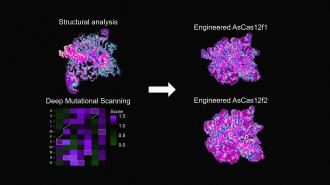A new CRISPR gene editor is much smaller than the original CRISPR-Cas9 system, which could make it a lot easier to treat diseases inside the human body.
Unlike some other attempts to shrink down CRISPR, this version works about as well as its bigger predecessor, potentially unlocking big advances in gene therapy.
The challenge: Scientists believe that gene editors, which can make precise changes to our cells’ DNA, have the potential to cure (or prevent) a vast number of diseases. One major difficulty, though, is getting them to where they’re needed.
CRISPR-based gene-editing tools consist of two main parts: a strand of RNA that matches to a target bit of DNA and an enzyme that edits the DNA once it’s located. Cas9 was the first enzyme used for CRISPR gene editing, and it’s currently the most popular, but it has limitations — a major one being its large size.
CRISPR-Cas9 is typically too large to fit in the viruses commonly used to deliver gene therapies.
Adeno-associated viruses (AAVs) are one of the best ways to get gene therapies into the body: they don’t cause diseases in people, can enter many types of cells, and are less likely to trigger a significant immune reaction. However, they’re also small.
While CRISPR-Cas9 offers a more precise way to do gene therapy, the system is typically too large to fit in AAVs. Breaking it down into two components — Cas9 and its RNA guide — and delivering them with separate AAVs can work, but that approach is typically less effective at editing cells than a system delivered in one package.
A new CRISPR system: Cas9 isn’t the only CRISPR enzyme, though, and some are much smaller. However, those aren’t as effective as Cas9 at gene editing. Not naturally, anyways.
By studying all the ways a smaller CRISPR enzyme, AsCas12f, could mutate, a team at the University of Tokyo identified more than 200 mutations that would make it a more efficient gene editor. They then combined select mutations to create their own version of the enzyme, which is one-third the size of Cas9.
“This engineered AsCas12f has more than 10 times the genome-editing activity.”
Osamu Nureki
When they tested the new CRISPR system in live mice, it was far better than one with a natural AsCas12f enzyme.
“This engineered AsCas12f has more than 10 times the genome-editing activity compared to the usual AsCas12f type and is comparable to Cas9, while maintaining a much smaller size,” said study leader Osamu Nureki.
Looking ahead: While the engineered AsCas12f enzyme was better at gene editing than the one that exists in nature, there still might be room for improvement — the researchers note that computer modeling or AI could potentially identify a better combination of mutations.
They also point out that their same mutation-focused approach could be used to optimize other Cas enzymes, making them even more powerful weapons in the fight against genetic disorders.
“For us the crucial aspect of gene therapy is its potential to genuinely help patients,” said Nureki. “Using the engineered AsCas12f we developed, our next challenge is to actually administer gene therapy to aid people suffering from genetic disorders.”
We’d love to hear from you! If you have a comment about this article or if you have a tip for a future Freethink story, please email us at tips@freethink.com.
